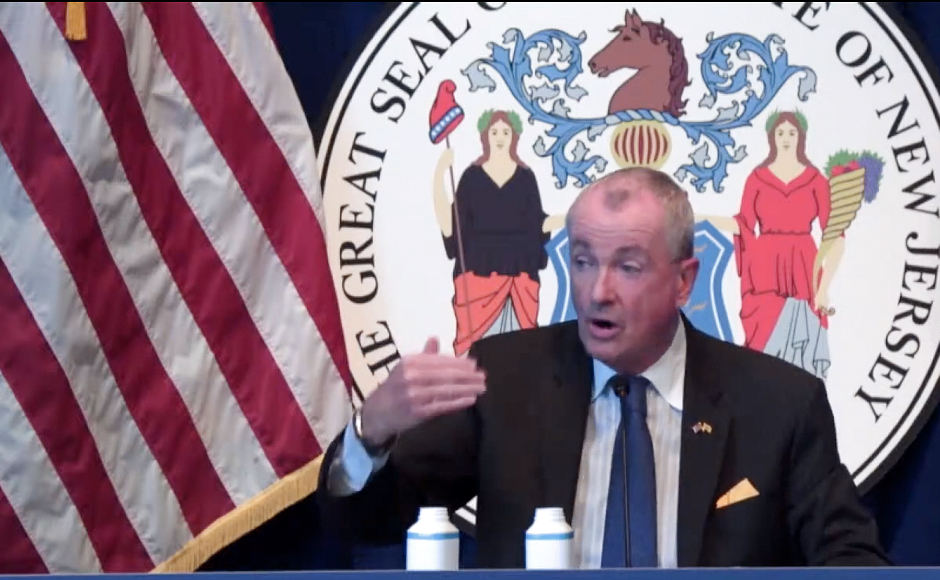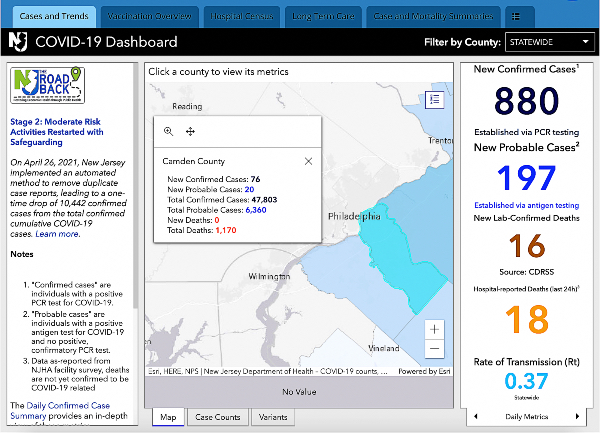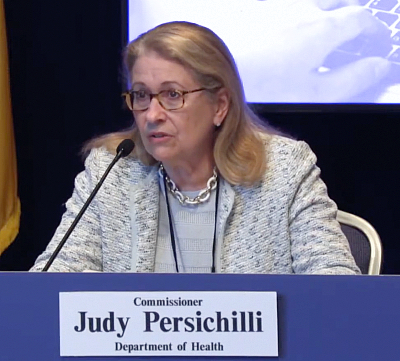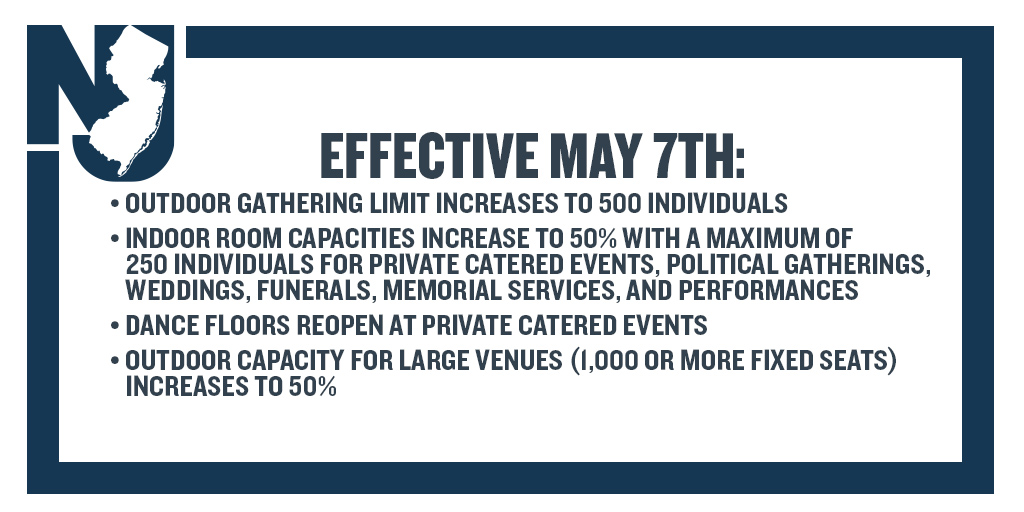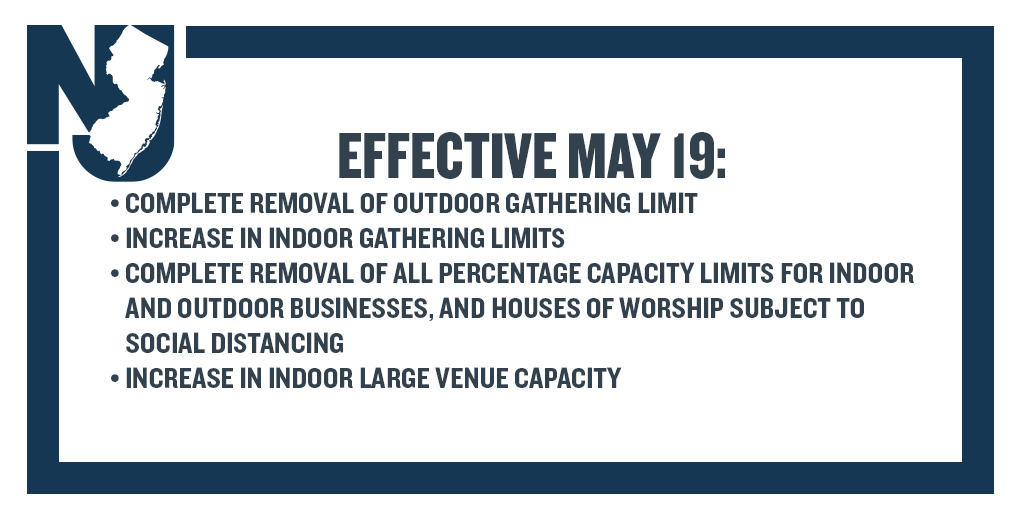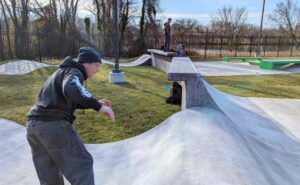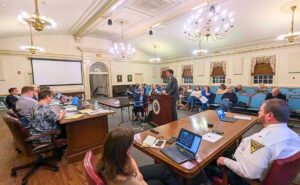Several gathering restrictions will be loosened starting May 7—three days earlier than previously planned—and relaxed even more fully May 19.
By Matt Skoufalos | May 3, 2021
Another 880 New Jersey residents have tested positive for novel coronavirus (COVID-19), bringing the statewide total to 876,141 cases confirmed via polymerase chain reaction (PCR) testing, Governor Phil Murphy reported Monday.
New Jersey is also reporting 197 new COVID-probable cases based on antigen tests, bringing the statewide total to 123,779 positive antigen tests.
Antigen tests have a faster turnaround time than PCR tests—sometime within 15 to 30 minutes—but are less reliable at detecting active infection of the virus and more capable of reporting false positives.
Sadly, 16 more residents have perished from complications related to the virus, bringing the statewide, confirmed death toll to 22,991 lives lost during the pandemic.
In addition to those lab-confirmed fatalities, the state has acknowledged another 2,625 probable COVID-19-related deaths.
Since March 2020, 873 of every 100,000 New Jersey residents have been hospitalized with COVID-19, and 262 of every 100,000 have died from COVID-19-related complications.
More than 13.533 million polymerase chain reaction (PCR) tests for COVID-19 have been performed statewide, with an 9.965-percent positivity rate per 100,000 residents.
Rate of transmission (Rt) at 0.37, spot positivity highest in South Jersey
The statewide average of COVID-19 spot positivity testing based on PCR test results stood at 4.94 percent April 29; in South Jersey, it was highest, at 6.78 percent.
Rt, the variable that describes the seven-day, rolling-average, statewide rate of transmission of new COVID-19 cases, hit 0.37 on April 26—an eight-month low, albeit one statistically misrepresentative, given that the state identified 10,000 duplicate, positive cases in its counts for that day.
An Rt figure greater than 1.0 means that each new COVID-19 patient is infecting more than one other person, on average, and the spread of the virus is increasing.
Since its mid-April-2020 COVID-19 spike, the highest reported RT in New Jersey was 1.48, recorded August 1, 2020. Prior to Monday’s report, the lowest in the past year was 0.62, recorded June 9, 2020.
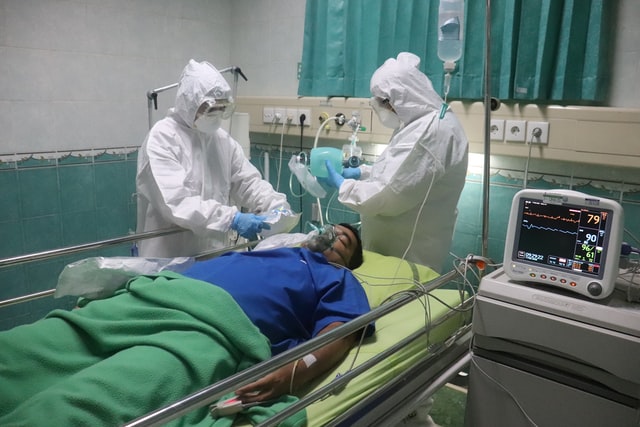
Simulated COVID-19 patient in a hospital bed. Photo by Mufid Majnun on Unsplash
Hospitalizations fall to 11-month low
Throughout New Jersey, 1,424 people currently are hospitalized with a suspected (107) or confirmed (1,317) case of COVID-19, Murphy said.
Among those hospitalized patients, 325 are in intensive or critical care, and 197 of the ICU and critical-care patients (61 percent) are on ventilators.
New Jersey Health Commissioner Judy Persichilli noted that the state’s hospital metrics are at lows unseen since June 2020, after the initial wave of the virus had subsided across the state.
In New Jersey’s 71 critical care hospitals, 128 patients were hospitalized with COVID-19 yesterday, while 148 others were discharged.
LTC update
Across the state, long-term care (LTC) centers have reported 1,424 cumulative outbreaks of COVID-19, and 218 are dealing with an active outbreak. LTCs account for 54,966 infected patients and staff in New Jersey, or 6.2 percent of total cases.
That includes 32,858 residents and 22,108 staffers sickened by the virus, as well as 8,030 lab-confirmed resident and staff deaths (35 percent of the statewide confirmed total), with facilities self-reporting 286 staff deaths.
Of 614 veterans residing in three state-run homes, 456 residents have tested positive for COVID-19, and 156 have died from complications related to the virus. The facilities at Menlo Park, Paramus, and Vineland are staffed by 1,344 workers, six of whom are presently COVID-19-positive. The facilities have sustained two staff deaths related to the virus.
Presently, one veteran is hospitalized with COVID-19; 300 have recovered from the virus.
At state-run psychiatric facilities, 357 of 1,123 patients and 1,044 staff members have tested positive for COVID-19. Fourteen patients and eight staffers have died from complications related to the virus.
MISC cases and schools
To date, 116 New Jersey children aged 1 to 18 have been diagnosed with pediatric multisystem inflammatory syndrome (MISC). Four of those cases were reported in Camden County, tied with Cumberland and Monmouth Counties for third-least in the state.
All those pediatric patients have tested positive for an active COVID-19 infection or the presence of COVID-19 antibodies, indicating exposure to the virus. No deaths have been associated with this syndrome in New Jersey, although several children have been hospitalized during their treatment.
Since August 1, 2020, 263 COVID-19 outbreaks encompassing 1,157 individual cases have been traced to schools in all 21 New Jersey counties. In Camden County, 17 outbreaks have been linked to 76 cases, fifth-most in the state.
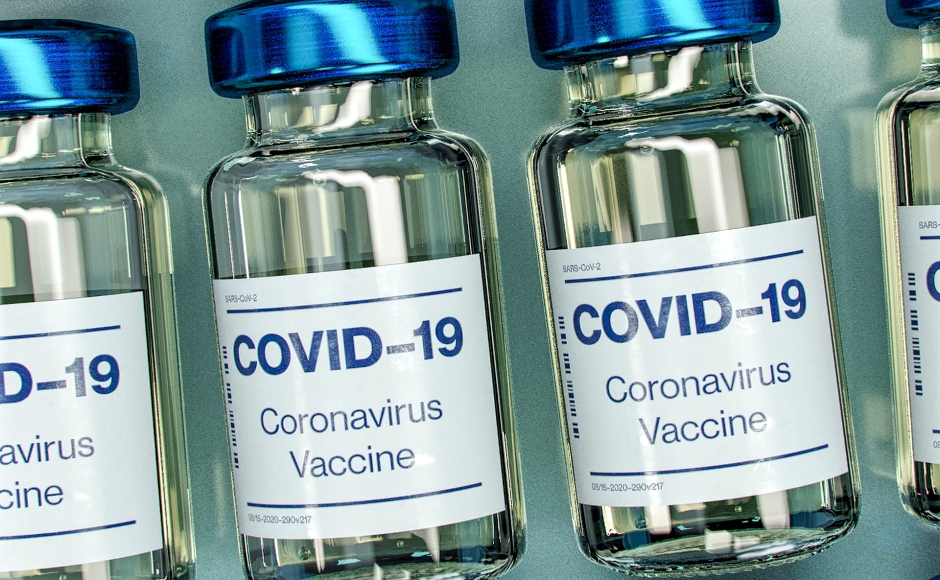
COVID-19 vaccine bottle mock-up. Photo by Daniel Schludi on Unsplash
Vaccination update: NJ surpasses 3M fully vaccinated people
Across New Jersey, 7.493 million COVID-19 inoculations have been administered.
Throughout the state, 3.112 million people are fully vaccinated, having received either a one-shot formulation from Johnson and Johnson or both doses of the two-shot Pfizer or Moderna vaccines.
In Camden County, 388,932 doses have been administered; seventh-most in the state.
Persichilli also noted that an estimated 357,874 New Jersey residents have received a vaccine dose outside of the state, of which 156,261 are estimated to have been fully vaccinated.
The first vaccines in the state were administered December 15, 2020; by February 8—55 days later—New Jersey had immunized its millionth resident. Twenty days thereafter, that count hit 2 million, and 3 million within two more weeks.
On March 29, New Jersey crossed the 4-million-dose threshold, and the state cleared 5 million doses over the weekend of April 10, 2021. Eight days after that, New Jersey hit the 6-million-dose mark. By May 3, 2021, the state had cleared 7 million doses administered.
Of those New Jersey residents aged 65 and older, 75.4 percent have received at least one vaccine dose, as have 74.8 percent of those age 75 and older, Murphy said.
The state is working to make access to vaccinations easier to come by, facilitating walk-up vaccinations at its vaccine megasites—no appointments necessary—and incentivizing inoculations with free beers at participating breweries.
NJ records 3,147 cases of variants of concern
Mutated offshoots of COVID-19, or “variants of concern,” continue to circulate throughout New Jersey; the state has traced 3,147 such cases to date.
The most common COVID-19 variant in the United States is the B.1.1.7, or “UK” variant, which has been detected in all 21 New Jersey counties.
In total, 2,901 B.1.1.7 cases have been spotted in the state.
It’s associated with a 50-percent increase in COVID-19 transmission over earlier strains of the virus detected in New Jersey, and likely increased severity, based on hospitalization and case fatality rates, Persichilli has said.
New Jersey also has recorded 97 cases of the P.1 “Brazilian” variant, seven reports of the B.1.351 “South African” variant, and 142 reports of the California variants B.1.427 and B.1.429.
The South African variant has demonstrated a 50-percent increase in transmission over other strains of COVID-19, and the California variants appear to show a 20-percent increase in transmission of the virus.
Cases have also been reported of strain B.1.526, which has been reported as originating in New York.
Roughly 2 percent of positive samples are being tested for variants, said Dr. Ed Lifshitz, head of the New Jersey communicable disease service, adding that state officials would like to increase testing to better be able to trace those variants.
Outlier COVID-19 cases
In addition to commonly reported data points, New Jersey health officials are tracking COVID-19 outlier statistics, including the number of residents who’ve suffered repeat infections of the virus, and those who constitute “breakthrough” cases; i.e., those who test positive for the virus at least two weeks after having been completely vaccinated.
There are technical issues around calculating these data, Lifshitz said, including communications among various vaccination repositories, and complications related to testing positive as recovered persons continue to shed viral particles. However, he said that officials “do have a general idea” about this information, and expects to be able to report it “within the next week or so.”
NJ advances reopening timetable
Citing improved pandemic statistics, including increased vaccination rates, improved hospitalization and viral transmission data, Murphy announced an updated executive order to ease capacity controls for indoor and outdoor gathering.
In coordination with similar changes coming to neighboring New York and Connecticut, New Jersey will move up its reopening timetable to May 7, rolling back restrictions that had been set to relax by May 10. Included in these rollbacks are requirements to maintain social distancing and face coverings indoors (and outdoors when unable to keep six feet apart).
Starting this Friday, outdoor gathering limits will increase from 200 to 500 people, with venues of 1,000 or more fixed seats increasing to 50 percent of capacity while maintaining six-feet distances among groups. Venues with 2,500 or more seats will increase to 30 percent of capacity while maintaining the same distance.
Indoor, catered events, including political events, weddings, funerals, memorial services, and performances, will also increase from 35 to 50 percent of capacity, up to 250 people.
Dance floors at private, catered events will be allowed to open with dancers masked and in socially distanced groups; dance floors at bars and nightclubs will remain closed.
Carnivals and fairs will be allowed to operate at the same capacity as outdoor amusements, the prohibition on indoor bar seating will be lifted, as will restrictions on self-service food, like buffets.
If its numbers continue to improve, New Jersey will also restore its indoor retail and service businesses to full capacity starting May 19, with patrons required to remain masked and socially distant. These actions align with those taking place in New York and Connecticut along the similar timetable.
“This new distance-based maximum capacity will apply across commercial settings, including retail, food services, gyms and fitness centers, amusement and family entertainment, hair salons, barber shops and other personal care services, among other settings,” Murphy said in a written statement.
“Businesses will only be limited by the space available for patrons, or parties of patrons, to maintain the required social distance of six feet,” he said.
Attendees at outdoor gatherings will still be required to remain six feet apart from other groups, but no gathering limits will be in effect starting May 19. Indoors, the limit for general social gatherings, including parties and in-home events, will be raised from 25 to 50 people.
Commercial events, including conferences, trainings, senior programming, and club meetings, are subject to the 250-person indoor event limit, provided that all attendees can remain six feet apart.
“Any business, whether indoors or outdoors, that is subject to a percentage capacity limitation will instead be guided by the rule regarding six feet of distance between persons or groups of persons,” Murphy said in his announcement.
The rule will apply to restaurants, houses of worship, gyms, salons and other personal care services, recreational businesses, and pools.
By the same token, indoor catered events, funerals, memorial services, performances, and political activities will no longer face percentage-based capacity restrictions starting May 19, only social distance restrictions, up to 250 individuals.
Finally, large, indoor venues will increase from 20 to 30 percent of capacity, with six feet of distance between groups, and the definition of a large venue will shift from a 2,500 fixed-seat building to a 1,000 fixed-seat building.
The bulk of the remaining restrictions will likely remain in place until such time as the U.S. Centers for Disease Control (CDC) revises its guidance about the necessity for social distancing, Murphy said. That will affect indoor capacities at businesses including bars and restaurants, although the governor pointed to the resumption of bar and buffet service as some consolation for the time being.

